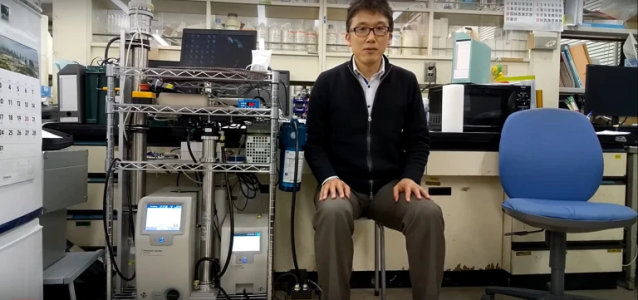
A helpful science experiment shows that masks, whether bought in a store or made at home, can help protect you against coronavirus.
People in China, Korean, and Japan have always used masks as protection against the common cold, the flu, and even seasonal allergies. With the coronavirus outbreak, though, the rest of the world is coming around to the idea of wearing masks when out, with national governments outside Asia starting to recommend their use, but there’s some debate. Are masks really effective protection against the virus?
Thankfully, there’s science to help us figure it out! Dr. Tomoaki Okuda, Associate Professor of Applied Chemistry at Keio University, did an experiment that measured the amount of particles in the air without a mask, with a surgical mask, with a homemade paper towel mask, and with a mask made from a cloth handkerchief. Essentially, he tested whether masks of each of the three varieties were effective at blocking particles in the air, and the results were pretty interesting.
For his experiment, Okuda used a Scanning Mobility Particle Sizer (SMPS), whose hose sucks in the air of the room and measures its concentration of particles per cubic centimeter. Okuda set it to only look for the concentration of particles that are around the estimated size of the virus, which is believed to be between 20 and 100 nanometers in diameter.
▼ The screen of the SMPS displays a chart that shows the concentration of particles per cubic centimeter on the vertical axis, and the size of particles on the horizontal axis. In short, the resulting graph bars show the concentration of each particle diameter per cubic centimeter.
As a control experiment, Okuda ran the hose without anything covering it, and the SMPS measured about 6,000 particles per cubic centimeter of air in the room that are between 10 and 150 nanometers in size. Now, imagine that you’ve come in contact to someone who is contagious with the disease, and among the 6,000 particles per cubic centimeter you’re breathing in, there are a fair amount of virus particles in the air. Without anything covering your mouth and nose as you breathe in, the chance of you being infected could be pretty high, right?
So, Okuda tried wrapping an ordinary surgical mask, like those sold in drug stores, around the top of the hose. The air that the SMPS measured now had significantly lower amounts of particles than before; somewhere around 1,800 per cubic centimeter. Okuda estimates that this means that surgical masks are able to collect about 60-70 percent of particles of that size. That means that the majority of virus particles won’t make it through the mask as you’re breathing in.
Then Okuda tried a “mask” made out of three paper towels that had been folded in half; essentially the same as six layers of paper towels that have been stacked one on top of the other. Surprisingly, the paper towels were more efficient at catching particles than the surgical masks. According to the SMPS, the air sucked through the paper towel mask had only about 1,000 particles of that size per cubic centimeter, with a collection efficiency rate of about 80 percent.
▼ The paper towels also seemed particularly effective on much smaller particles.
In the final experiment, Okuda used a handkerchief that had been folded over three times. When placed over the SMPS hose, it had a similar effectiveness as the surgical mask, reducing the particles in the air down to 1,800 particles per cubic centimeter. Though he doesn’t specify what kind of fabric his handkerchief was made of, we might guess that it was a more common variety of cotton or polyester, which those of us ordinary people could find easily.
Okuda did mention that the virus particulars are smaller than the gaps between the fibers of a mask, but he said they aren’t likely to slip between the fibers because they move in Brownian motion. Essentially that means they don’t move in a straight line, but randomly, because they are bumping into the molecules in the air. Because of that, the likelihood of them moving straight between the fibers is low, and they’ll likely get caught among the fibers of whatever material was used to make the masks.
So there you have it! Science seems to indicate that masks are reasonably effective at catching particles that are the same estimated size is the COVID-19 virus. You might notice that 60 to 80 percent isn’t completely effective…but that’s still significantly less COVID-19 viruses you could potentially be breathing in, and at any rate, with a mask you’ll probably be touching your face less, too, so it seems worth trying if you really want to protect yourself and those you love.
Can’t find any masks at your local drug stores? Don’t worry, Twitter taught us how to make one using paper towels–though we might suggest using more than one sheet–and the Daiso was kind enough to show us how to make one out of cloth, so there are several options available for you. And don’t forget to study up on the right way to wear a mask before you go out!
Source, images: YouTube/Tomoaki OKUDA
● Want to hear about SoraNews24’s latest articles as soon as they’re published? Follow us on Facebook and Twitter!

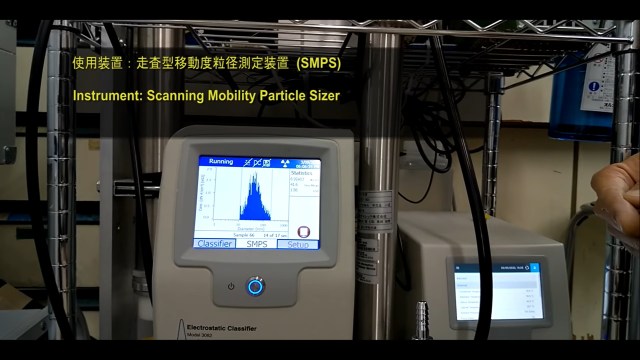
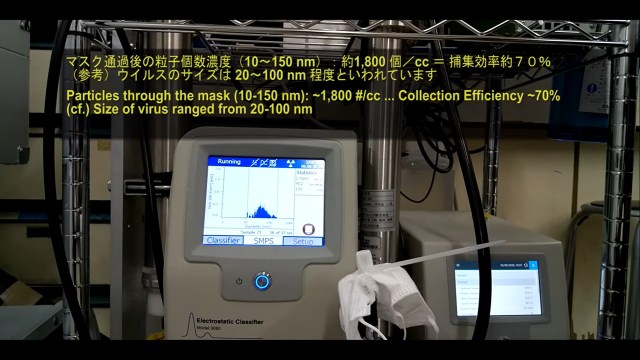
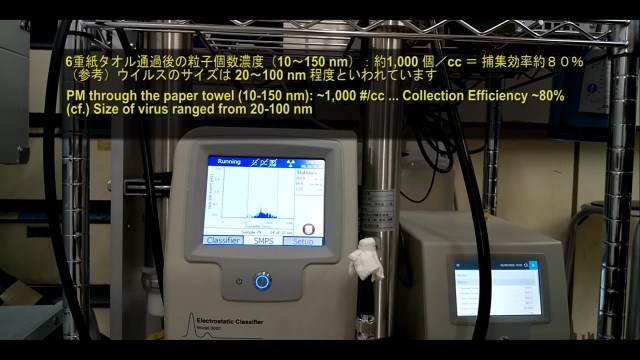
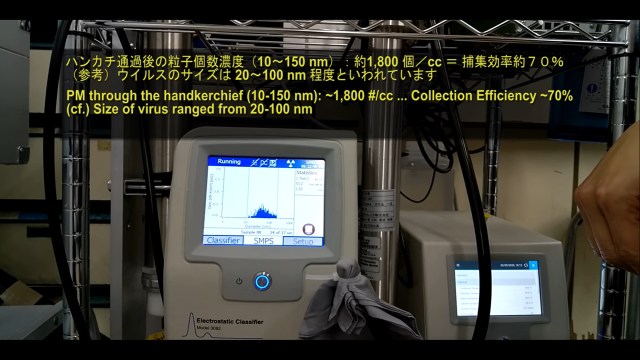
 World-first confirmation that masks can protect you from coronavirus【Video】
World-first confirmation that masks can protect you from coronavirus【Video】 Kobe hospital robbed of 6,000 surgical masks
Kobe hospital robbed of 6,000 surgical masks Japanese fashion company develops fabric mask with velcro-edge eating technology
Japanese fashion company develops fabric mask with velcro-edge eating technology Japanese government may encourage people to reuse masks as coronavirus-caused shortage continues
Japanese government may encourage people to reuse masks as coronavirus-caused shortage continues Japan creates world’s first edible face mask…from melon bread
Japan creates world’s first edible face mask…from melon bread Foreigner’s request for help in Tokyo makes us sad for the state of society
Foreigner’s request for help in Tokyo makes us sad for the state of society Seaside scenery, history, and so many desserts on Yokohama’s Akai Kutsu【Japan Loop Buses】
Seaside scenery, history, and so many desserts on Yokohama’s Akai Kutsu【Japan Loop Buses】 Japanese city loses residents’ personal data, which was on paper being transported on a windy day
Japanese city loses residents’ personal data, which was on paper being transported on a windy day Should you add tartar sauce to Japanese curry rice? CoCo Ichi makes diners an unusual offer
Should you add tartar sauce to Japanese curry rice? CoCo Ichi makes diners an unusual offer Ghibli Park now selling “Grilled Frogs” from food cart in Valley of Witches
Ghibli Park now selling “Grilled Frogs” from food cart in Valley of Witches Historical figures get manga makeovers from artists of Spy x Family, My Hero Academia and more
Historical figures get manga makeovers from artists of Spy x Family, My Hero Academia and more The results are in! One Piece World Top 100 characters chosen in global poll
The results are in! One Piece World Top 100 characters chosen in global poll French Fries Bread in Tokyo’s Shibuya becomes a hit on social media
French Fries Bread in Tokyo’s Shibuya becomes a hit on social media Our visit to the coolest Book Off used Japanese book store that we’ve ever seen
Our visit to the coolest Book Off used Japanese book store that we’ve ever seen Mt. Koya planning to instate visitor’s tax to cope with huge tourist numbers
Mt. Koya planning to instate visitor’s tax to cope with huge tourist numbers McDonald’s new Happy Meals offer up cute and practical Sanrio lifestyle goods
McDonald’s new Happy Meals offer up cute and practical Sanrio lifestyle goods Japanese ramen restaurants under pressure from new yen banknotes
Japanese ramen restaurants under pressure from new yen banknotes Studio Ghibli releases new action figures featuring Nausicaä of the Valley of the Wind characters
Studio Ghibli releases new action figures featuring Nausicaä of the Valley of the Wind characters Red light district sushi restaurant in Tokyo shows us just how wrong we were about it
Red light district sushi restaurant in Tokyo shows us just how wrong we were about it New private rooms on Tokaido Shinkansen change the way we travel from Tokyo to Kyoto
New private rooms on Tokaido Shinkansen change the way we travel from Tokyo to Kyoto Tokyo Tsukiji fish market site to be redeveloped with 50,000-seat stadium, hotel, shopping center
Tokyo Tsukiji fish market site to be redeveloped with 50,000-seat stadium, hotel, shopping center Beautiful Ghibli sealing wax kits let you create accessories and elegant letter decorations【Pics】
Beautiful Ghibli sealing wax kits let you create accessories and elegant letter decorations【Pics】 Studio Ghibli releases Kiki’s Delivery Service chocolate cake pouches in Japan
Studio Ghibli releases Kiki’s Delivery Service chocolate cake pouches in Japan New definition of “Japanese whiskey” goes into effect to prevent fakes from fooling overseas buyers
New definition of “Japanese whiskey” goes into effect to prevent fakes from fooling overseas buyers Our Japanese reporter visits Costco in the U.S., finds super American and very Japanese things
Our Japanese reporter visits Costco in the U.S., finds super American and very Japanese things All-you-can-drink Starbucks and amazing views part of Tokyo’s new 170 meter-high sky lounge
All-you-can-drink Starbucks and amazing views part of Tokyo’s new 170 meter-high sky lounge More foreign tourists than ever before in history visited Japan last month
More foreign tourists than ever before in history visited Japan last month New Pokémon cakes let you eat your way through Pikachu and all the Eevee evolutions
New Pokémon cakes let you eat your way through Pikachu and all the Eevee evolutions Disney princesses get official manga makeovers for Manga Princess Cafe opening in Tokyo
Disney princesses get official manga makeovers for Manga Princess Cafe opening in Tokyo Sales of Japan’s most convenient train ticket/shopping payment cards suspended indefinitely
Sales of Japan’s most convenient train ticket/shopping payment cards suspended indefinitely Sold-out Studio Ghibli desktop humidifiers are back so Totoro can help you through the dry season
Sold-out Studio Ghibli desktop humidifiers are back so Totoro can help you through the dry season Japanese government to make first change to romanization spelling rules since the 1950s
Japanese government to make first change to romanization spelling rules since the 1950s Ghibli founders Toshio Suzuki and Hayao Miyazaki contribute to Japanese whisky Totoro label design
Ghibli founders Toshio Suzuki and Hayao Miyazaki contribute to Japanese whisky Totoro label design Doraemon found buried at sea as scene from 1993 anime becomes real life【Photos】
Doraemon found buried at sea as scene from 1993 anime becomes real life【Photos】 Tokyo’s most famous Starbucks is closed
Tokyo’s most famous Starbucks is closed One Piece characters’ nationalities revealed, but fans have mixed opinions
One Piece characters’ nationalities revealed, but fans have mixed opinions We asked a Uniqlo employee what four things we should buy and their suggestions didn’t disappoint
We asked a Uniqlo employee what four things we should buy and their suggestions didn’t disappoint Princesses, fruits, and blacksmiths: Study reveals the 30 most unusual family names in Japan
Princesses, fruits, and blacksmiths: Study reveals the 30 most unusual family names in Japan We test out Uniqlo’s “new and improved” Airism mask for form, fashion, and function
We test out Uniqlo’s “new and improved” Airism mask for form, fashion, and function 100-yen store Daiso teaches us how to make our own cloth face masks
100-yen store Daiso teaches us how to make our own cloth face masks Conjure a magical barrier to block virus particles with an anime magic circle-inspired partition
Conjure a magical barrier to block virus particles with an anime magic circle-inspired partition We try cooling our face masks five different ways, and don’t recommend doing any of them
We try cooling our face masks five different ways, and don’t recommend doing any of them Train brought to emergency stop because someone coughed in it
Train brought to emergency stop because someone coughed in it 16 facts about China that will blow your mind
16 facts about China that will blow your mind Wearing a white mask will make you less attractive, according to Japanese researchers’ experiment
Wearing a white mask will make you less attractive, according to Japanese researchers’ experiment Osaka bus driver flunked alcohol test after eating steamed bread
Osaka bus driver flunked alcohol test after eating steamed bread No screaming on roller coasters, please, say Tokyo Disneyland, other Japanese amusement parks
No screaming on roller coasters, please, say Tokyo Disneyland, other Japanese amusement parks Ghibli Museum reveals new social distancing rules for visitors ahead of reopening【Videos】
Ghibli Museum reveals new social distancing rules for visitors ahead of reopening【Videos】 Think Beijing’s famous smog Is bad? Delhi’s is worse 【Photos】
Think Beijing’s famous smog Is bad? Delhi’s is worse 【Photos】 Demon Slayer manga creator offers a motivational illustration during the pandemic
Demon Slayer manga creator offers a motivational illustration during the pandemic “Eco-pochi” indoor plants will add style to your home and remove stinky smells, too!
“Eco-pochi” indoor plants will add style to your home and remove stinky smells, too! Mask vending machines pop up at train stations around Taiwan to help commuters avoid fines
Mask vending machines pop up at train stations around Taiwan to help commuters avoid fines Why Ghibli’s Nausicaä of the Valley of the Wind is the perfect film for 2020
Why Ghibli’s Nausicaä of the Valley of the Wind is the perfect film for 2020 Special warm face masks for winter go on sale in Japan, and we test them out
Special warm face masks for winter go on sale in Japan, and we test them out
Leave a Reply